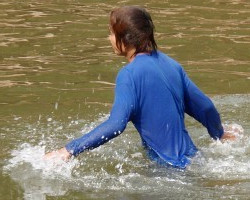Wading for Wildlife Watching
Wading is a necessary and common requirement for wildlife watching on big still waters, small rivers and along the sea shore.
Easily one of the best things about wildlife watching in the summer is wet wading, being able to feel more connected to the surroundings. There’s something very primal about feeling the water working its way around your legs and into your clothes. We’ve always felt that is makes us part of the river rather than just a visitor.
A level of separation exists when you’re in dry waders. While this is necessary for comfort and safety in the cold. When it’s warm, why not get a little closer to the outdoors and let your clothes get wet? This has both emotional and practical.

On a more emotional note, there’s just something nice about sharing the water directly with the animals you’re watching.

On a practical level, being in direct contact with the water and the ground, without massive boots and thick waders, gives you a keener sense while wading. It’s easier to feel different currents and rocks while wet wading, which is helpful in difficult areas of the river.
Wading Safety
Wear comfortable clothes that avoid injury. Never wade unless you have prior knowledge or someone to guide you as to where it is safe to wade and where it is not. Never wade unless you are with someone. Then if one of you gets into difficulty the other can call for help.


Falling in
As you wade over rugged terrain in rivers, lakes, or the sea, you may occasionally stumble and fall into the water. This is part of the game, so get with it. Your waders on top of your clothes avoid cuts and bruises.
One of the biggest traps of waders is thinking you and your belongings will definitely stay dry. If you fall with dry waders they fill up with water, which could be a heavy problem when getting up. We’ve seen more damage to possessions in dry waders than we care to say, simply because people assume they won’t fall in and flood themselves.
You might as well just lower the risk of falling anyway and ditch dry waders. Wet waders let the water run out at the bottom. Being comfortable in the water will make you a better wader. You can't enjoy wildlife watching if you are being distracted by personal discomfort.
You’re less likely to fall while wet wading and you’ll already be wet, so unless you were only wading up to your ankles, you probably won’t get much wetter after a fall. On the same note, since you’re already wet, you probably already put your essentials (camera, phone, keys, wallet, etc.) in a safe place, too. If you’re wet wading, you’ve probably found a better home for these items, so falling won’t matter.
Feeling comfortable on and in the water is important.
We don’t want to waste time changing our outfits and making adjustments because of poor planning.
Investment in nice wading clothes is worth your time.
The short-term investment will keep you happy in the water for years to come.
Wading Stick
Always wade with a proper wading stick, not granddads old walking stick or one of the latest collapsible sticks. More people fall into the water because of collapsible wading sticks (both the pouched elasticated version and the screw to concertina version) than for any other reason. They collapse just when you are least expecting it.
A good stick must be straight and strong enough to support your whole weight without bending or breaking. It must be long enough to keep the handle out of the water when you are wading chest deep, ie floor to under your arm pit when you are standing straight. It must be weighted in the base sufficient to stay on the bottom in a strong current, which means a lot heavier than you might think.
The lanyard must be of the correct length so that you can extend your arm fully but not so long that you cant reach the stick when loose in the water. The lanyard must have a breakaway clip mechanism so that if you are being dragged under by the stick (assuming you have already fallen in) you can easily lose it if necessary. Don’t worry you will pick it up later as the weight will keep it on the bottom where you lost it.
Next always remember to wear the wading stick on your downstream shoulder.
That way it will not get in your way or worse trip you up.
Some sticks have a special clip mechanism for carrying on your back when not in use.
Lifejacket
If you wish to survive an accident, wear a lifejacket. It will turn a fully unconscious body the right way up in still water. A buoyancy aid of vest will not, it is just what it says, an aid to staying afloat which is why it is used for most inshore yachting and watersports etc.
If your lifejacket is built into your wading jacket it must be zipped up to work properly.
Always remember to wear the lifejacket on the outside of your clothing.